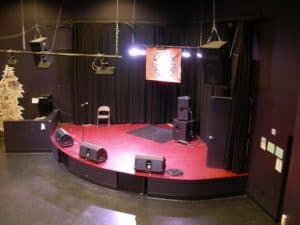There is nothing more frustrating than trying to deal with audio feedback when using a PA. If you are an audio technician, you must have come across many instances when you wish the world could just open up and swallow you when feedback occurs during a live event with a band or singers. If you are going to deliver a great sound experience for everyone, you need to find out how to prevent feedback in your PA system. Before we start looking at ways of getting rid of this problem, let’s look at what causes it.
What Causes Feedback?
The issue occurs when the amplified signal from any loudspeaker re-enters the PA through the microphone. This feedback loop causes the audio to be amplified again and again. The continuous amplification of the audio is what results in an irritating screeching sound or ringing sound that nobody wants to hear. When feedback occurs, the speakers might either produce a rumbling effect or screeching. Such kinds of distractions are not what you need to deliver a quality listening experience.
A simple PA system would comprise a loudspeaker, an amplifier, and a microphone. When the sound is spoken through the microphone, the signal travels to the amplifier where it is amplified before it comes out through the speaker. However, for you to attain an audio system that can be used to address a large crowd or perform a live concert, you will need more than just the basics. You will have multiple mics, speakers, amplifiers, equalizers, mixers among other tools. All these tools would have an impact on your mix.
If your sound setup was as simple as a microphone, a speaker, and an amplifier, you would simply have to ensure that the microphone is facing away from the speaker. This way, it will not be able to pick up any sound from the speaker and hence no feedback. However, when you have a larger setup, the task of preventing feedback also becomes complex. Wireless microphones can present feedback difficulties when the user is encouraged to move about the stage. In moving around, the position of the microphone to the loudspeaker is constantly changing, multiplying chances of feedback. Here are tips to help you get rid of the feedback when you are dealing with a large PA and one of the best ways to control bad frequencies is to properly tune everything. You should check out my other post on this topic here-> PA system tuning
Common problem frequencies
Low 250-500Hz – howling sound
Mid 1kHz – singing or ringing type sound
High above 2kHz – whistles, screeching
However, remember this is just a general guide and that every PA system is unique to both the amp, speakers, mics and layout of the room. Your own setup will have it’s own unique frequency profile.

Some feedback prevention tips
1.Ring it Out
If you are using a well-developed configuration, you should not be experiencing many problems with feedback. It should only become a problem when one of the people performing directly points the mic to a monitor. Most musicians pay attention to their performance and do not care about how you set up your audio. All they want, is to hear the music on stage clearly, even when they are the cause of the problem. If you anticipate any such issues, use the “ringing out” technique to get rid of the problem.
This is how it works.
– When setting up, it is better to bring the volume level up until you begin to hear the acoustic feedback. Once you hear it, manage what you are hearing with your frequency equalizer. Lower the offending signal frequency by 3dB. If you get a howl, try cutting in the range of 250 to 500 Hz. Generally, a singing tone frequency should be around 1kHz. On the other hand, the screeching tone will hit at 2kHz and the issue rarely occurs for frequencies below 80Hz. One of the most important things you can do is to develop a keen ear when setting up your mixing console and amps etc., and this will help you reduce the problem. Make sure the microphone is in position or move it around the stage to different positions if you have a singer who might move around a bit. If you have an acoustic guitar in front of a microphone, try the guitar at various distances and angles from the mic to see if that reduces troublesome frequencies. You might want to readthis post to find out how to get a mic sounding good.
2. Reduce Frequency Travel Time
There is usually a problem when sound waves have to travel a long distance, such as in a large hall or church. One of the best ways to ensure that you do not get feedback is having your microphone close to the singers or instruments and far away from the loudspeakers. When the mic is too far away from the source of the audio, the sound waves have to travel longer distances and this increases the chances of interactions between signal frequencies.
3. Control The Midrange
When you are in a small venue, chances are that the echo will cause some audio feedback. This could be very frustrating because there is little you can do about the echo immediately as the room acoustics are pretty much fixed. If you have to use the venue for a long time it is advisable to install absorbing material to reduce the echo. However, when you are just using such a venue temporarily, the only option is to manage the condition from front of house. You can try to cut down the echo. The solution is not to turn down the volume level and gain, but to try to manage when feedback occurs with your graphic equalizer. As long as you have enough bands on your analyzer, you should be able to handle each frequency causing the trouble. The difficulty in most cases is with the midrange frequencies. If you can reduce the midrange feedback frequencies, you will reduce the audio effect so significantly such that no one who is not a mixing engineer will be able to notice.
4. Manage Your Microphones
The greatest cause of feedback with live sound is the availability of many vocal microphones picking signals from the loudspeakers and stage monitors. If a microphone isn’t being used, always switch it off on the mixing console. If you are using wireless mics, for instance, you should place them on stands. When singers hold a mic in their hands they tend to point them in the wrong directions. If your singers are using wireless microphones and moving about the stage, it can be more difficult to manage signal feedback, especially with floor monitors. Too high gain on the mics could lead to acoustic feedback in the room, but if singers are closer to mics, then you can lower the gain.
5. Feedback Eliminator
While they may not be able to help much in a small venue, audio feedback eliminator might help you control the feedback. They work well when you are using wireless mics. When the performer moves close to the loudspeaker, the feedback controller will help deal with any unwanted frequencies quicker than any sound engineer can.

FAQs
Is there such a thing as an anti feedback microphone?
Not really. All microphones feedback, but there are some that cause less problems than others. Although cardioid mics like the SM58s are very popular for vocals, they do cause problems for audio engineers struggling to manage feedback. Supercardiod and Hypercardoid mic are apparently better, because they are more directional and less susceptible to feedback from sound coming from the sides. A number of people mention the Audix OM5 as a good mic to try if you are having acoustic feedback issues. The Sennheiser 945e is also worth cosnderation.
What is an automatic feedback reducer?
Automatic feedback reducers or feedback eliminators, as they are sometimes called, are basically EQ units that automatically detect troublesome sound frequencies and get rid of them. An example of this is the Behringer FBQ1000 or the Behringer Ultracurve Pro DEQ2496.
Conclusion
The task of a tech team is to ensure that the sound coming from the PA system is clean and audible. However, attaining a clean mix is not always easy. You could encounter problems such as frequency interference and echo especially in smaller facilities. However, the worst problem for most engineers is always microphone feedback. It’s mainly caused by the amplified signal from the speaker reentering the system and getting amplified again. You can use any of the above audio techniques to help you find a way around it. Always ensure that the microphones are far from the speakers and close to the source. Use an equalizer to handle the audio feedback. Switch off any mics that are not in use and put them on stands to avoid any picking up unwanted signals.

Leave a Reply